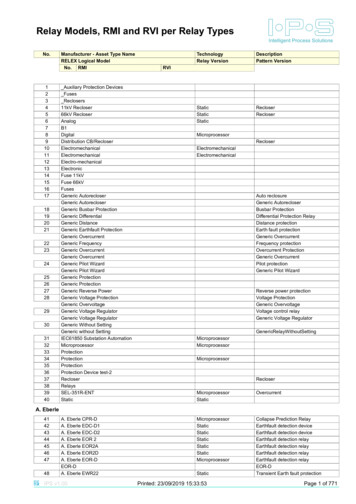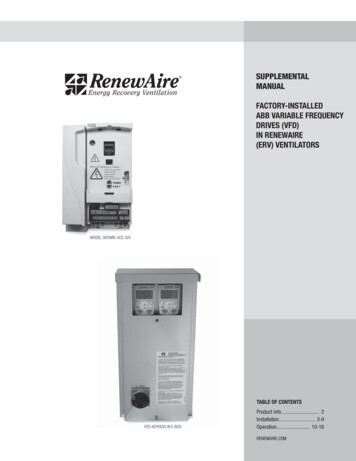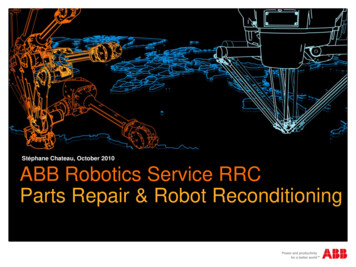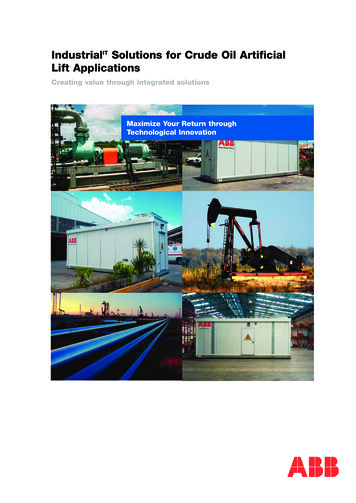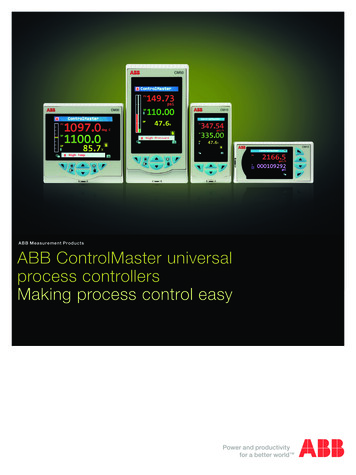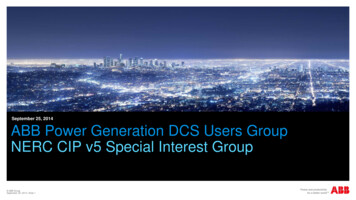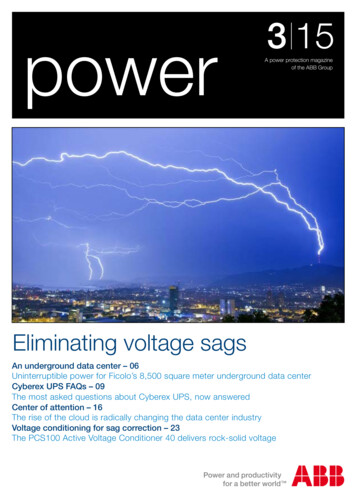
Transcription
power3 15A power protection magazineof the ABB GroupEliminating voltage sagsAn underground data center – 06Uninterruptible power for Ficolo’s 8,500 square meter underground data centerCyberex UPS FAQs – 09The most asked questions about Cyberex UPS, now answeredCenter of attention – 16The rise of the cloud is radically changing the data center industryVoltage conditioning for sag correction – 23The PCS100 Active Voltage Conditioner 40 delivers rock-solid voltage
ABB has released the PCS100 AVC-40 Active VoltageConditioner designed for sag correction in large commercialand industrial applications. Watch the video here.2ABB power 03 15
Editorial3 15powerYou can find out even more in ourarticle on ABB's Cyberex industrialUPS. Have you ever wonderedwhat is involved in specifying aUPS battery bank? Or why fusesare used instead of breakers onUPS distribution panels? Or howa UPS should be sized? To havethese, and many other, questionsanswered have a look at the indepth Cyberex article.Kevin BickerstaffeProduct Group Global Sales ManagerPower ProtectionDiscrete Automation and Motion divisionWelcome once again to ourmagazine. A lot has happenedsince our last edition and in thisissue we have some excitingupdates and stories that covera wide range of our products.And that product range hasjust increased with the releaseof our PCS100 AVC-40 andPCS100 AVC-20 Active VoltageConditioners (AVCs). Theseproducts take care of the voltagebeing supplied to industrialinstallations – if the voltagelevel sags or surges, the AVCwill instantly correct it. Not onlythat, but the AVC also providescontinuous voltage regulation– so constant, quality power isguaranteed. To see all the greatfeatures of these innovativeproducts be sure to watch thevideo that accompanies thearticles on the PCS100 AVC rangeof products.Our business is global and ourUPS products find their way intoapplications that are many andvaried. In Finland, for example,we are supplying UPS capabilityto Ficolo, one of the big Finnishcolocation companies – ie, acompany that provides data centercapacity for users to rent storageor processing power, as opposedto a data center that is dedicatedto one enterprise.computing and the massivechange it is catalyzing in the ITlandscape. This rapid redefinitionof an entire industry offers a uniqueopportunity to companies whoare able to supply the ultra-reliableand flexible uninterruptible powersystems needed by the cloudinfrastructure. What are the currenttrends in this area and how arethey likely to play out over thenext decade? Find out more in thearticle “Center of attention: The riseof the cloud is radically changingthe data center industry”.In conclusion, it just remains forme to thank you all once again foryour support and for reading thisupdate.Enjoy this issue of power.Ficolo’s data center is locatedin three large excavated halls ina network of tunnels originallyconstructed by the Finnish DefenceForces during the Cold War. Sixfurther halls are available, but havenot yet been kitted out. This sortof location is ideal for our modulardecentralized parellel architecture(DPA) UPS.DPA is fully scalable and can beinstalled module by module aspower requirements grow, so asthe new halls are brought intoservice they can be equippedwith just the right number of UPSmodules – this saves the customerbuying a lot of capital equipmentup front that may not be used for afew years.Staying in the data centerbusiness, we are looking at cloudABB power 03 153
Contents06An underground data centerUninterruptible power for Ficolo’s 8,500 squaremeter underground data center in Ulvila09Cyberex UPS - FAQsFrequently asked questions about Cyberex UPS,now answeredFeature06 UPS technology going undergroundUninterruptible power for Ficolo’s 8,500 square meter underground data center in UlvilaUPS09 Cyberex UPS – FAQsFrequently asked questions about Cyberex UPS, now answered16 Center of attentionThe rise of the cloud is radically changing the data center industryPower conditioning23 ABB's PCS100 AVC-40Designed for sag correctionPower 03 15. Issue 3. June 2015 Power protection customer magazine from ABB Copyright 2015 Editor : Power protection marketing teamEmail : powerconditioning@abb.com Any use of text or photos requires the written consent of the publisher4ABB power 03 15
Contents16Center of attentionThe rise of the cloud is radically changingthe data center industry23ABB’s PCS100 AVC-40Designed for sag correctionABB’s Power Protection cannow be found on Facebook.“Like us” to stay up to date withcompetitions, giveaways and thelatest news releases.The power converters andinverters playlist can now befound on the ABB’s YouTubechannel.Click here to watch the latestvideos.Click here to like ABB PowerProtection.Scan our QR Codes with your smart phoneto find web links, videos or event pages,providing further details about ABB’sproducts or services. Scan the one on theleft to subscribe to Power. To use QR Codeswith your smart phone camera, download afree QR Code scanner to your phone.Haven’t subscribed yet?It’s not too late. Click here toreceive the next issue of Powerfree.Contact Us – power protection made eABB power 03 155
Power protection – feature storyABB’s modular UPS system ensures the reliability of the data center power supply and perfectly supports the customers need in terms of scalability and flexibilityAn undergrounddata centerEnsuring uninterruptible power for Ficolo’s8,500 square meter underground datacenter in Ulvila.6ABB power 03 15
Power protection – feature story“Ficolo’s data center is located in Ulvila, in an underground tunnel network covering8,500 square meters, originally quarried for the Finnish Defence Forces” explainsFicolo’s CEO, Seppo IhalainenFinland has an affordable, stable and secure electricitysupply, as well as a safe, predictable political climate.Along with favorable legislation, this makes Finland aperfect location for a global data center, making it one ofthe world's most competitive countries in this sector.Ficolo is a major Finnish colocation company that recognizesthe advantages of its home country. Ficolo’s CEO, SeppoIhalainen, says “costs in Finland are four to six times lowerthan the rest of Europe. The data center we have constructedin the Ulvila location is ideal. It is just outside one of the mostbuilt-up parts of the country and it brings with it inherent costsavings, energy efficiency and security.”Technology in deep rock cavesFicolo’s data center in Ulvila is in an 8,500 square meterunderground tunnel network originally excavated by theFinnish Defence Forces. Inside the geological formations thereare nine halls, each between 500 and 800 square metersin size. In May 2014, three of the halls were brought up tooperational condition.The halls can be dedicated to specific customers or sharedby several customers. Ihalainen observes, “Our investmentcosts can be optimized with this facility. New halls can bebrought online as required, and the caves that lie empty donot incur any costs while they wait to be kitted out. We alsohave the ability to expand our ABB modular uninterruptiblepower supply as needed – this scalability is vital to us so wecan grow the installed UPS as the power requirements grow.And we don’t have to make a major, upfront speculativeinvestment. The individual data center halls operate entirelyindependently of one another and our colocation model allowscustomers to choose between a centralized or distributed datacenter solution that best fits their needs.”Electrical security a top priorityIhalainen continues, “a reliable electricity supply is critical tothe data center business and having our supply backed upby ABB UPS systems is ideal. We also use wind-turbinegenerated power together with diesel generators as a backupsource. This means that customer service continues as normalin the event of a grid power outage."ABB was able to provide the UPS technology quickly; wesubmitted the order on Christmas Eve and by February wewere up and running. The ABB installation engineers, EinarKinnunen and Jani Nissinen, showed exceptional diligenceand commitment, enabling this large contract to be fulfilled onschedule. The system is ideal for our business model, bothtechnically and financially."Energy efficient solution for data centersABB offers technologies, technical solutions and professionalservices for data centers. Energy-efficient, cost-effectivesolutions are provided for data centers by intelligent design,construction, commissioning, testing and operation as well asallowing for flexibility and scaling.Various security systems are built in to the Ulvila installationto ensure network, fire and physical safety. Energy efficiency,green and renewable energy, and waste heat recovery are alsoimportant aspects of the data center operations. "There is alsoa project on-going to use recovered waste heat to help powerUlvila city,” says Ihalainen.There are huge growth prospects, as Ficolo’s is the first datacenter to bring the colocation business model to Finland.Ficolo pursues an agile approach, in which the customer canchoose the depth and breadth of cooperation, outsourcingeither all or part of its IT Services. Traditional global hostingduplication is eliminated.Ihalainen estimates that after five to eight years all nine hallswill be sold out due to the continuing growth of enterprise ITsystems and business-critical systems. “Large internationalcompanies can depend on us as their data volumes continueto grow alongside their need to have guaranteed reliabilityregardless of what crisis comes up.”Modularity increases usabilityABB provided Ficolo with a truly modular high-efficiencyDPATM UPS concept which scales to changing needs. Systemreliability is ensured by the modularity of double conversionABB power 03 157
Power protection – feature storyABB's modular UPS product rangetechnology and the in-built redundancy. Hot swappablemodules keep the system operational and repair times short.DPA module replacement does not require an expert engineerto be on-site and the part can be sent to ABB for service orrepair.The availability, flexibility and reliability of the power supply, andits cost, are critical to data centers, as well as hospitals, mediahouses, telecom sectors and the process automation industry.UPS systems are essential to protect these critical servicesand maximizing efficiency keeps energy costs to a minimum.Each module has all the hardware and software needed forautonomous operation - rectifier, inverter, battery converter,static bypass switch, back-feed protection, control logic,display, and mimic diagram for monitoring and control. Theother modules take up the load if one module is defectiveor if it is removed for service or repair. The only commoncomponent of the system is at the five-module rack level. Upto six racks can be connected to form one very powerful UPS.To find out more about ABB’s UPS solutions:Web: www.abb.com/ups or DPA modular pageABB’s DPA UPSs operate with an efficiency of up to 96percent and their scalability minimizes power losses, therebymaximizing energy efficiency.A reliable and flexible UPS is a basic requirement in today'sbusiness-critical environment as problems with powergeneration or supply can cause outages or quality issues suchas voltage dips, spikes or frequency variations and harmonics.ABB's UPS website8ABB power 03 15
Power protection – UPSCyberex UPS –FAQsFrequently asked questions about CyberexUPS, now answered.ABB power 03 159
Power protection – UPSWhat is a UPS?A UPS is an electrical device that provides continuous,conditioned, uninterrupted power to a critical AC load. It alsoprovides isolation between the input and the output. It consistsof a rectifier/battery charger, battery system and inverter. Thebattery charger converts incoming commercial/utility AC powerto DC power. This power is then supplied both to a batterysystem and an inverter. The inverter then converts this DCpower back into AC power which is fed to the critical load(s).The battery is an emergency DC supply that is connected inparallel with the output of the battery charger, and suppliesthe DC power to the inverter (without any switching) in theevent that the incoming commercial power is lost or outside ofspecified tolerances.A true UPS is an on-line system, which means that undernormal operating conditions, the power flow is through thebattery charger, then through the inverter to the load. ThisWhen the battery is depleted, the inverter will turn off, andthe load will go down. In order for a power supply to beconsidered a true UPS, it must accept three sources ofpower. The first source is the commercial, or utility, powerthat supplies AC power to the battery charger; the second isthe battery, which provides emergency DC power. The thirdsource is a bypass, or alternate, AC source, which providesemergency AC power to the load if the inverter is unableto supply power, either because of an inverter failure, or afault on the load. Under these conditions, the load would beautomatically transferred to the bypass source via a static(electronic) transfer switch.The bypass source also supplies power in the event that theload is transferred manually from the inverter via a manualmaintenance bypass switch. A true on-line UPS is also referredto as a double conversion system. This means, as the nameimplies, that the power is converted twice. First it is convertedfrom AC to DC at the rectifier; then it is converted back fromDC to AC at the inverter. Another common term isreverse transfer. This refers to the fact that the load,under certain conditions as described above (faults,equipment failure or manual operation), is transferredback onto the commercial/utility power source.A UPS is an electrical device thatprovides continuous, conditioned,uninterrupted power to an AC loaddiffers from off-line, or stand-by systems, which are designedsuch that under normal conditions, power for the load issupplied directly from the commercial power source, NOTthrough the inverter. Depending on the design, and cost, thepower may be conditioned by means of a voltage regulatingtransformer or power conditioner placed in the power pathbetween the commercial power source and the load. In anoff-line or standby system, the inverter only supplies powerto the load if the utility power fails. The battery then picks upthe inverter load for a finite period of time (typically 15 to 20minutes).10ABB power 03 15Again, this differentiates it from an off-line systemwhere, under normal operation, the load is poweredfrom the utility source.How do I size batteries for UPS applications?UPS batteries are sized to provide emergency back-up powerto the UPS in the event of a total AC blackout. While it is oftena matter of convenience or personal preference, the length ofback-up time required is primarily a function of the processbeing protected. It is also governed by the cost of the battery.Since a UPS is utilized to provide continuous power to aprocess of one kind or another, the batteries should be sizedto carry the load for as long as it takes to either complete theprocess, perform an orderly shut-down of the process, orbring a generator on-line to power the load. A UPS inverter
Power protection – UPSBattery typeTypical warrantyLife expectancyHydrogen gasevolutionApprox. number ofdeep chargesInitial cost comparisonto lead calciumLead calcium wet cell20 years20 yearsLow to moderate100100%Lead calcium VRLA10 years5 yearsNone2003–50%Lead calcium VRLA20 years15 yearsNone20080–120%Lead antimony wet cell15–20 years15 yearsHigh400100%Nickel cadmium wet cell20–25 years20–25 yearsLow1000250–300%Table 1: Comparison between battery technologiesconverts DC power to AC power. The battery must be sizedlarge enough to provide the DC input power (in kilowatts) fora fully loaded inverter for the specified length of time. The DCinput power is determined by applying the load power factor,and inverter conversion efficiency to the inverter’s AC powerrating.Next, you must determine the DC bus voltage, and thecorresponding number of battery cells. Then, you candetermine the battery capacity per cell required for the load.(Note that a battery has a nominal voltage of 2 volts per cell.So, on a nominal 120 VDC bus, you will need 60 cells.) Then,using discharge data supplied by a battery manufacturer, youcan determine the battery type and size required. Followingis a typical battery sizing example: 20kVA UPS (inverter) witha DC to AC conversion efficiency of 87 percent; a load powerfactor of 0.8, and a nominal 120 VDC bus.20kVA x 0.887% 60 cells16 kW87% 60 cells18.39 kW 0.307 kW/cell60 cellsUsing discharge tables supplied by the batterymanufacturer(s), select the type of battery that meets theabove requirements of 0.307 kilowatts per cell. Please notethat complex load duty cycle profiles, commonly called stepload profiles, should be referred to your UPS supplier forproper sizing.What are the advantages/disadvantages of differentbattery technologies?There are several different types of batteries available forUPS applications. However, they basically break down intotwo technologies: Lead Acid and Nickel Cadmium. Lead acidbatteries are further divided into two types: Lead Calciumand Lead Antimony. Lead calcium batteries can be brokendown into two categories: traditional wet cell (or flooded) andvalve regulated lead acid (or VRLA – sometimes mistakenlyreferred to as maintenance free). The proper battery for a givenapplication is dependent upon a number of factors. (Referto table 1 for a quick comparison between batterytechnologies).1. Ambient temperatureThe optimum average ambient temperature for batteriesis 25ºC. Ambient temperatures above that will significantlyreduce battery life. The rule of thumb is that an increase inambient temperature of 9.4ºC above 25ºC will reduce thebattery life by 50 percent.Certain battery types are more susceptible to the effects oftemperature than others. For example, a VRLA battery with afive or 10 year design life is much more prone to prematurefailure due to temperature extremes than a wet cell with a20 or 30 year design life. The least susceptible is the nickelcadmium battery. Although they are affected by temperatureextremes, they can withstand slightly higher ambienttemperatures than other types. But caution dictates that thesame 'rules' be applied to all batteries equally.2. Number of discharge cyclesBatteries are rated in two general duty, or service, categories:'float' service or 'cycling' service. Batteries considered to bein float service are only rarely called upon to carry a load.Cycling batteries (such as those designed for UPSapplications), on the other hand, experience many dischargecycles over their useful life, with the depth of discharge ranginganywhere from several seconds, to a 100 percent discharge.Lead antimony and nickel cadmium batteries typically offer the'best' cycling service. That is, they are designed to providetwo to five times the number of discharges of other batterytypes, such as flooded or 20 year VRLA. A Five or 10 yearVRLA, as you would expect, will accommodate the leastnumber of discharges.3. MaintenanceOne of the trade-offs to using lead antimony batteries is thatthey expel greater amounts of hydrogen into the atmospherewhen discharging. This requires more frequent maintenance,such as the addition of water. By far, the least amount ofmaintenance is required on the 10 and 20 year valve regulatedABB power 03 1511
Power protection – UPSbatteries, since they do not expel hydrogen gas under normaloperation. Lead calcium wet cell batteries do require somemaintenance, and fall somewhere in the middle. Anotheraspect of maintenance for flooded batteries is the periodicmeasuring of specific gravity to insure the batteries are fullycharged. All battery types require periodic tightening of batteryterminals and connections.4. Physical SizeValve regulated batteries are designed for maximum powerdensity. That is, they deliver a large amount of power per cubicinch. Nickel cadmium batteries also have a high power density.Typically, if battery room space is at a premium, a valveregulated or nickel cadmium battery may be the best choice,because you get “more bang for your buck” in a limited space.5. Expected life/warrantyA five or 10 year valve regulated battery can be expected tolast two to five years, depending on the number of dischargesit experiences, the ambient temperature and other factors. A20 year wet cell or valve regulated battery will generally last 15to 20 years, if properly maintained. A nickel cadmium batterymay last 25 to 30 years. Battery warranties are typically oneyear full, with the balance pro-rated. In other words, a 20 yearbattery will carry a 12 month full warranty, with the remaining19 years prorated against the manufacturer’s list price.Extended warranties are often available.One unfortunate thing about batteries is that, no matter howmuch you pay for them, they are essentially a consumablepart, and need to be replaced periodically. Of course, thereare many factors that affect how frequently this needs tohappen, but eventually, even under ideal service conditions,they will need to be replaced. The real downside to this is thatit is not always possible to predict exactly when the batteriesare near their end of life although in this instance wet cellbatteries have a distinct advantage over valve regulated types.There are several ways to determine the status of wet cellbatteries. 1) You can measure the specific gravity of a cell,and make determinations as to electrolyte levels; 2) you canmeasure cell temperature (which actually should be done inconjunction with specific gravity readings); 3) you can performa visual inspection of the battery jar to determine the amountof sediment in the bottom; 4) you can perform a discharge teston the battery.One advantage of the Cyberex Industrial UPS is it's small footprint, meaning it can beretrofitted into sites where there is limited spaceTypically, if battery room space is at apremium, a valve regulated or nickelcadmium battery may be the bestchoice, because you get “more bangfor your buck” in a limited spaceWith VRLA batteries, because the jars are sealed,the best way to get an accurate indication of battery life andcapacity is to perform a periodic discharge test. There are alsoseveral types of battery monitoring systems on the market, butthe results of using those have been somewhat mixed.12ABB power 03 15
Power protection – UPSThe CBEMA curve defines the voltagetolerance levels and duration thatcomputers and other electrical controldevices can safely operate within withoutcorruption of data6. CostWith batteries, it is generally true that “you get what youpay for.” Nickel cadmium batteries offer the best overallperformance – less susceptible to temperature extremes;greater number of cycles; greater power density; lowmaintenance; and greater life expectancy. However, the tradeoff is that the initial cost can be two to three times that of a 20year wet cell lead calcium battery. A 20 year valve regulatedbattery is comparably priced (usually within 10–20 percent)with a 20 year wet cell battery. As you might expect, a five or10 year battery is priced accordingly.Why fuses instead of breakers for UPS distributionpanels?The goal of any well designed UPS system is to maintainpower to the load at all times. However, since the output ofthe UPS is generally fed through a distribution panel board tothe load, there may be times when an overload or fault occurson one or more branch circuits that have the potential fordropping the load(s) on that branch. This condition needs tobe limited to only that branch, and not affect any other loads,or upstream electrical equipment. Therefore, it is imperativethat the fault condition be cleared as quickly as possible. Mostmolded case breakers, used as branch breakers in panelboards, take two to three cycles (50 milliseconds) before theywill open under short circuit or fault conditions. Fast-actingfuses, such as the Gould Shawmut A25X , however, havemuch faster clearing characteristics, typically 1/4 cycle (4milliseconds).Many UPS systems (inverters) will not provide enough faultclearing current for the two to three cycles required to clearthose types of breakers. Fuse clearing energy of a powersource can be expressed in terms of its I2-T capability. Forexample, a Cyberex inverter is able to deliver 150 percentof its rated output for 15 minutes without transferring to thebypass. A fault or short circuit of sufficient magnitude that issustained for long enough could eventually cause damage orcascaded failures to other loads under what is referred to aspanel pull-down.Other types of inverters, which are not designed with theenergy storage capability of Cyberex inverters, will only supplyapproximately 10 to 15 percent of the fault clearing energy ofinverters. This severely limits their ability to clear faults withouttransferring to an alternate source.What is pulse-width-modulation (PWM)?A PWM inverter employs high speed switching power devicesto generate a series of “pulses” in the inverter bridge tosimulate a sine wave. This signal is then filtered and fed tothe load through a linear transformer. Due to the advancedtechnology behind the industrialized standard of using PWMinverters, it has a very tight voltage regulation during steploading and unloading (be it 0 to 100 percent, 100 to 0percent, 0 to 50 percent, 50 to 0 percent, etc) of betweentwo to five percent of nominal under any operating condition.Loads are not compromised due to step loading or unloading.Other technical benefits are higher efficiencies, smallerfootprint, advanced metering/monitoring, and lower audiblenoise.What is the CBEMA curve and what does it mean?CBEMA stands for Computer Business EquipmentManufacturer’s Association. The CBEMA curve defines thevoltage tolerance levels and duration that computers and otherelectrical control devices, such as Programmable LogicControllers (PLCs) can safely operate within without corruptionof data. The curve shows that voltage transients of certainmagnitudes, say 250 percent, are acceptable for short periodsof time – 100 microseconds. That same transient with aduration of say 1/2 cycle (8.33 milliseconds) would causedisruption of data.The curve also shows that voltage levels below nominal arealso acceptable, provided they do not exceed the magnitudeABB power 03 1513
Power protection – UPSComputers and other extremely sensitive equipment are affected by even very short term power fluctuationsand duration defined by the curve. For example, a voltagedeviation of up to -30 percent held for that same 1/2 cycle,would not cause a disruption of data. Indeed, the curve showsthat voltage levels of even zero can be tolerated for a very briefperiod of time – say four milliseconds (1/4 cycle). That samezero voltage level sustained for longer than 1/4 cycle couldwreak havoc on data.Losing voltage for only a little more than 1/4 cycle (8.33milliseconds) seems insignificant, but for a computer, or otherextremely sensitive equipment, it can be a lifetime.The significance of the CBEMA curve in UPS applications isimportant when considering a UPS (or inverter) with anelectronic (static) transfer switch. This switch is critical tothe overall reliability and up time of the UPS (and its load)because it is able to transfer the load from the inverter to analternate AC power source to clear downstream faults whennecessary, or in the event of an inverter failure. The abilityto do this quickly and seamlessly is vital to the load. Thisseamless transfer must take place in both directions. Moststatic switches are designed to retransfer the load back ontothe inverter after the fault or overload has been cleared. Thisretransfer should also cause no disruption of power. But,inevitably, there is a voltage deviation of some magnitude andduration when making this transfer. Therefore, it is extremelyimportant to understand the implications of these voltagedeviations. As has been pointed out, a voltage deviation ofup to 30 percent, for example, can be tolerated for up to 1/2cycle or more. Much has been made in the past of inverters14ABB power 03 15that display a “lower” voltage deviation (commonly referred toas transient response) than some other types of inverters.However, the CBEMA curve shows that electronic devicesdon’t care whether the level is higher or lower, just as long asit is within acceptable limits. A PWM inverter will always staywithin the CBEMA curve and the acceptable limits of loadpower supplies.How do I size my UPS?A UPS is designed and sized to provide continuouspower to an AC load. The term continuous is a key wordbecause many AC loads, such as motors, require a great dealmore power (current) during start-up, than the actual “running”current. A typical rule of thumb is that start-up current for amotor, commonly referred to as “locked rotor current” iseight to 12 times the actual running or steady-state current;otherwise you could end up with a UPS that is eight to 12times larger than what your load actually requires. It will beshown below how to avoid this problem when sizing your UPS.The current measurement used to determine the load is theRMS value, rather than the peak value. (Note: If only thepeak value is known, the RMS value can be determined bymultiplying the peak value times 0.707). Once the load currentis determined, the capacity of the UPS can be determinedsimply by multiplying the RMS current by RMS voltage. Thisresult is the Volt Ampere (VA) capacity required of the UPS. On3-phase systems, multiply the result by 3 (1.732).
Power protection – UPSA phenomenon associated with today’s electronic loads,such as computer and control devices, is the introductionof switch-mode power supplies. These power supplies arenon-linear i
The PCS100 Active Voltage Conditioner 40 delivers rock-solid voltage Eliminating voltage sags power A power protection magazine of the ABB Group. 2 ABB power 03 15 . Email : powerconditioning@abb.com Any use of text or photos requires the written consent of the publisher . stable and secure electricity supply, as well as a safe .
